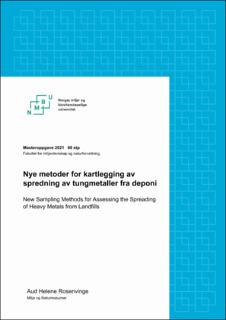| dc.contributor.advisor | Okkenhaug, Gudny | |
| dc.contributor.advisor | Smebye, Andreas Botnen | |
| dc.contributor.author | Rosenvinge, Aud Helene Hagen | |
| dc.coverage.spatial | Norway | en_US |
| dc.date.accessioned | 2021-11-30T10:34:47Z | |
| dc.date.available | 2021-11-30T10:34:47Z | |
| dc.date.issued | 2021 | |
| dc.identifier.uri | https://hdl.handle.net/11250/2832042 | |
| dc.description.abstract | Sigevann fra deponier, hvor det er deponert en blanding av gammelt husholdningsavfall og industriavfall samt gravemasser fra utbyggingsprosjekter, inneholder en mengde stoffer som det er viktig at ikke spres til resipienter på utsiden. Selv om deponiene i prinsippet skal være tette og med god kontroll på sigevannet vil lekkasjer til overvann og grunnvann kunne skje, spesielt fra gamle anlegg. Derfor er det satt krav i lovverket og utslippstillatelsene om overvåkning og oppfølging av mulig påvirkning på miljøet på utsiden av deponiene. Dagens praksis med fire stikkprøver i året kan gi mangelfull informasjon om tilstanden i resipientene fordi det kun blir et øyeblikksbilde. I tillegg vil ikke måling på totale konsentrasjoner alltid gjenspeile hvordan og i hvilken grad forurensningene er toksiske for organismene som lever i resipientene.
Formålet med denne oppgaven har vært å undersøke om nye og mer innovative prøvetakingsmetoder enn dagens praksis med stikkprøver kan gi bedre grunnlag for å vurdere forurensning av en bekk nedstrøms deponiet på Lindum i Drammen. I studien er det undersøkt om blandprøver, passive prøvetakere som Diffusive gradients in thin films (DGT) og SorbiCell kan tilføre nye og mer relevante data for overvåking av resipienten. Hovedfokuset har vært på parameterne kobber, nikkel og sink som har forhøyede konsentrasjoner i bekken. Det er også benyttet geokjemisk likevektsmodellering ved hjelp av programmet Visual Minteq, for å kartlegge hvilke tilstandsformer disse elementene foreligger i.
Resultatet fra undersøkelsen viser at metodene som er testet og en kombinasjon av metodene gir verdifulle data og et mer fullstendig situasjonsbilde for å gjøre risikovurderinger av deponiets påvirkning på omgivelsene. Spesielt i forhold til den økologiske tilstanden i bekken vil dette kunne være et nyttig supplement til dagens overvåkingsregime med stikkprøver. Det anbefales at slike metoder i fremtiden bør bli en del av overvåkingsprogrammet ved deponiet på Lindum. | en_US |
| dc.description.abstract | Leachate from landfills, where waste from both households and industry have been disposed of together with excavated soils from development projects, often contain a number of harmful substances which should not be released into the environment. Although landfills should, in principle, be sufficiently sealed so as to have complete control of this leachate, leakages to surface and groundwater can occur, especially from older landfills. Legislative requirements have therefore been implemented with landfill owners having to monitor the effect of leachates on the local environment by taking regular leachate samples. Currently, only four leachate samples per year are mandatory. As this small amount of data provides only a snapshot of a longer time period, insufficient information about the condition of the recipient waterways can result. In addition, measurements of total concentrations of the leachate will not always reflect how and to what extent the contaminants are toxic to the organisms that live in these vulnerable environments.
The aim of this thesis was to investigate whether new and more innovative sampling methods than the current sampling practice can provide a better basis for assessing pollution levels of a creek downstream from Lindum’s landfill in Drammen, Norway. The study investigated whether mixing of regular samples and passive samplers such as Diffusive gradients in thin films (DGT) and SorbiCell can introduce new and more relevant data for monitoring of this creek. The main focus has been on the parameters copper, nickel and zinc of which elevated concentrations have been measured. Geochemical equilibrium modeling was performed via the program, Visual Minteq, to map the species of these elements.
The results from the study show that each of the methods tested as well as a combination of the methods provide valuable data and a more complete picture of the creek’s pollution levels. As they have assisted with the risk assessment process of the landfill's impact on the environment, these new methods could be a useful supplement to the Lindum’s current monitoring regime, and it is therefore recommended that they should be implemented in the future. | en_US |
| dc.description.sponsorship | Lindum AS | en_US |
| dc.language.iso | nob | en_US |
| dc.publisher | Norwegian University of Life Sciences, Ås | en_US |
| dc.rights | Attribution-NonCommercial-NoDerivatives 4.0 Internasjonal | * |
| dc.rights.uri | http://creativecommons.org/licenses/by-nc-nd/4.0/deed.no | * |
| dc.title | Nye metoder for kartlegging av spredning av tungmetaller fra deponi | en_US |
| dc.title.alternative | New sampling methods for assessing the spreading of heavy metals from landfills | en_US |
| dc.type | Master thesis | en_US |
| dc.description.localcode | M-MINA | en_US |

